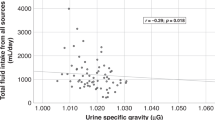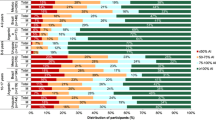Abstract
Background
Nutrient drink test (NDT) is a simple, non-invasive method to assess gastric function including accommodation. However, data on normal satiety drink volume (SDV) in children is scanty with no information about postprandial symptoms (PPS). Our aims were to establish normal values of NDT in healthy children and evaluate its correlation with age, gender, and anthropometry.
Methods
Six- to 18-year-old healthy children underwent the NDT. The nutrient drink (0.94 kcal/mL) was given at a constant rate of 15 mL/min in 6–12-year-old subjects and at 30 mL/min in 13–18-year-old subjects till satiety score of 5 was reached. Postprandial symptoms (30 min) of fullness, nausea, bloating, and pain were scored using a visual analogue scale (0–100 mm) individually and as aggregate score.
Results
Sixty-seven children (40 boys, age 12 [6–18 years]) were enrolled. Median SDV was 360 [180–960 mL], higher in 13–18-year-olds in comparison to 6–12-year-old children (360 [240–1002] vs. 300 [148–960] mL; p=0.005). SDV showed significant correlation with age, weight, and height. SDV was higher in boys than girls (450 [240–1074] vs. 330 [240–480] mL; p=0.02) in the older children (13–18 y), but it was similar in the younger children. Mild fullness (40 [0–80]) was the only PPS seen in 85% children and none had pain. PPS were not different between boys and girls or younger and older children.
Conclusion
The study provides normative data of SDV and PPS by NDT in 6–18-year-old children. SDV correlated with age and was higher in adolescent boys than girls.



Similar content being viewed by others
References
Hyams JS, Bruke G, David PM, Razepski P, Andrulonis PA. Abdominal pain and irritable bowel syndrome in adolescents: a community based study. J Pediatr. 1996;129:220–6.
Devanarayana NM, Mettananda S, Liyanarachchi C, et al. Abdominal pain-predominant functional gastrointestinal diseases in children and adolescents: prevalence, symptomatology, and association with emotional stress. J Pediatr Gastroenterol Nutr. 2011;53:659–65.
Devanarayana NM, Adhikari C, Pannala W, Rajindrajith S. Prevalence of functional gastrointestinal diseases in a cohort of Sri Lankan adolescents: comparison of ROME II and ROME III criteria. J Trop Pediatr. 2001;57:34–9.
Tack J, Demedts I, Meulemans A, et al. Role of nitric oxide in gastric accommodation reflex and meal induced satiety in humans. Gut. 2002;51:219–24.
Troncon LE, Bennett RJ, Ahluwalia NK, et al. Abnormal intragastric distribution of food during gastric emptying in functional dyspepsia patients. Gut. 1994;35:327–32.
Hata T, Kato M, Kudo T, et al. Comparison of gastric relaxation and sensory functions between functional dyspepsia and healthy subjects using novel drinking-ultrasonography test. Digestion. 2013;87:34–9.
Kindt S, Tack J. Impaired gastric accommodation and its role in dyspepsia. Gut. 2006;55:1685–91.
Boeckxstaens GE, Hirsch DP, van den Elzen BDJ, Heisterkamp SH, Tytgat GN. Impaired drinking capacity in patients with functional dyspepsia: relationship with proximal stomach function. Gastroenterology. 2001;121:1054–63.
Schwizer W, Steingotter A, Fox M, et al. Non-invasive measurement of gastric accommodation in humans. Gut. 2002;51:S59–62.
Tack J. Drink test in functional dyspepsia. Gastroenterology. 2002;122:2093–4.
Tack J, Caenepeel P, Piessevaux H, et al. Assessment of meal induced gastric accommodation by a satiety-drinking test in health and in severe functional dyspepsia. Gut. 2003;52:1271–7.
Tack J, Piessevaux H, Coulie B, Caenepeel P, Janssens J. Role of impaired gastric accommodation to a meal in functional dyspepsia. Gastroenterology. 1998;115:1346–52.
Chial H, Camilleri C, Delgado-Aros S, et al. A nutrient drink test to assess maximum tolerated volume and postprandial symptoms: effects of gender, body mass index and age in health. Neurogastrenterol Motil. 2002;14:249–53.
Hoffman I, Vos R, Tack J. Normal values for the satiety drinking test in healthy children between 5 and 15 years. Neurogastroenterol Motil. 2009;21:517–20.
Khadilkar V, Yadav S, Agrawal KK, et al. Revised IAP growth charts for height, weight and body mass index for 5- to 18-year-old Indian children. Indian Pediatr. 2015;52:47–55.
Crommer B. Adolescent development. In: Kliegman, editor. Nelson Textbook of Pediatrics, Vol. 1. 19th ed. Philadelphia: Saunders; 2011. p. 649–54.
Moo In Park. How to interpret nutrition drink test. J Neurogastroenterol Motil. 2011;17:88–90.
Mearadji B, Penning C, Vu MK, et al. Influence of gender on proximal gastric motor and sensory function. Am J Gastroenterol. 2001;96:2066–73.
Kindt S, Coulie B, Wajs E, Janssens J, Tack J. Reproducibility and symptomatic predictors of a slow nutrient drinking test in health and in functional dyspepsia. Neurogastroenterol Motil. 2008;20:320–9.
Jone MP. Satiety testing: ready for clinic? World J Gastroenterol. 2008;14:5371–6.
Hoffman I, Tack J. Assessment of gastric motor function in childhood functional dyspepsia and obesity. Neurogastroenterol Motil. 2012;24:108–12.
Author information
Authors and Affiliations
Corresponding author
Ethics declarations
Conflict of interest
US, AS, AM, SKY, and UP declare that they have no conflict of interest.
Informed consent
Informed consent was obtained from all participants included in the study.
Ethics statement
The study was performed in accordance with the ethical standards of the 1975 Helsinki declaration and its later amendments in 2000 and 2008 concerning human and animal rights.
Rights and permissions
About this article
Cite this article
Shava, U., Srivastava, A., Mathias, A. et al. Nutrient drink test: Normative values in Indian children. Indian J Gastroenterol 36, 405–410 (2017). https://doi.org/10.1007/s12664-017-0794-9
Received:
Accepted:
Published:
Issue Date:
DOI: https://doi.org/10.1007/s12664-017-0794-9




